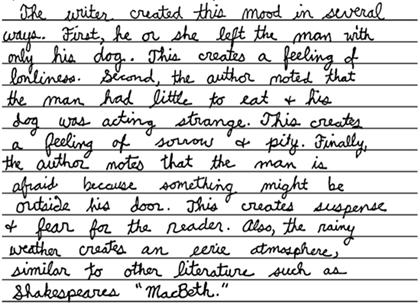Sample question 2 is a contructed-response question that asked students to interpret the overall mood or feeling of a short literary passage and then to explain how the writer of the passage created the mood. Responses to this question were rated with a 5-level scoring guide in one of the following categories:
5 - Mood identified and substantiated with multiple pieces of evidence
4 - Mood identified and substantiated
3 - Mood identified and substantiated with minimal evidence
2 - Mood identified without substantiation
1 - Unable to identify mood
See the full text of the reading passage below.
|
3 percent of 17-year-olds wrote responses rated at level 5.
|
Think about this article again. Write down a few words that describe the mood or feeling of the story.

Explain how the writer created this mood.


|
29 percent of 17-year-olds wrote responses rated at level 3.
|
Think about this article again. Write down a few words that describe the mood or feeling of the story.

Explain how the writer created this mood.

See more about this question in the NAEP Questions Tool.

Sample Reading Passage
Travels with Charley in Search of America
Even the cabin was dismal and damp. I turned the gas mantle high, lit the kerosene lamp, and lighted two burners of my stove to drive the loneliness away. The rain drummed on the metal roof. Nothing in my stock of food looked edible. The darkness fell and the trees moved closer. Over the rain drums I seemed to hear voices, as though a crowd of people muttered and mumbled offstage. Charley was restless. He didn’t bark an alarm, but he growled and whined uneasily, which is very unlike him, and he didn’t eat his supper and he left his water dish untouched—and that by a dog who drinks his weight in water every day and needs to because of the outgo. I succumbed utterly to my desolation, made two peanut-butter sandwiches, and went to bed and wrote letters home, passing my loneliness around. Then the rain stopped falling and the trees dripped and I helped spawn a school of secret dangers. Oh, we can populate the dark with horrors, even we who think ourselves informed and sure, believing nothing we cannot measure or weigh. I knew beyond all doubt that the dark things crowding in on me either did not exist or were not dangerous to me, and still I was afraid. I thought how terrible the nights must have been in a time when men knew the things were there and were deadly. But no, that’s wrong. If I knew they were there, I would have weapons against them, charms, prayers, some kind of alliance with forces equally strong but on my side. Knowing they were not there made me defenseless against them and perhaps more afraid.